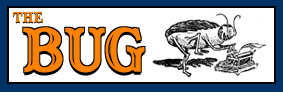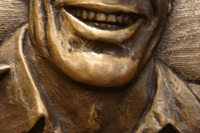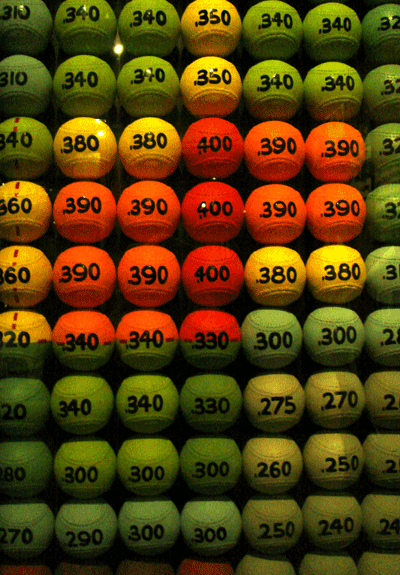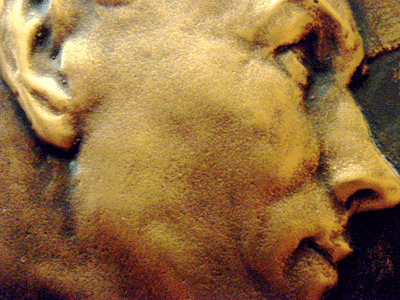 I have a rather cantankerous connection with the National Baseball Hall of Fame in Cooperstown, New York. By this I mean that I complain about the Hall and the Hall goes about its business ignoring curmudgeonly types like myself. I was a member for a very brief amount of time–maybe a year–when former President Dale Petroskey cancelled an appearance by Tim Robbins and Susan Sarandon, who were in town to promote the baseball film (and very good movie in general) Bull Durham. They were canned because of their outspoken opposition to the war in Iraq. So I quit the Hall. It was easy to do–their publications remain the zenith of pedantic writing, tedious essays that either extol the noble sport as a paragon of boyhood, patriotism, or mythology, which is exactly the crap I hate.
I have a rather cantankerous connection with the National Baseball Hall of Fame in Cooperstown, New York. By this I mean that I complain about the Hall and the Hall goes about its business ignoring curmudgeonly types like myself. I was a member for a very brief amount of time–maybe a year–when former President Dale Petroskey cancelled an appearance by Tim Robbins and Susan Sarandon, who were in town to promote the baseball film (and very good movie in general) Bull Durham. They were canned because of their outspoken opposition to the war in Iraq. So I quit the Hall. It was easy to do–their publications remain the zenith of pedantic writing, tedious essays that either extol the noble sport as a paragon of boyhood, patriotism, or mythology, which is exactly the crap I hate.
Petroskey, who I understand is actually a gentleman, was let go recently, and I rejoined. I would have come to see this shrine regardless of whether that former president was wandering the halls (which I hear he did, often engaging with people gaping at the plaques). Understand: in spite of my constant irritation with this place, the Hall of Fame is a place I’ve been wanting to visit my whole life.
That’s often how it is with baseball. Though I hate it when people compare baseball to a religion, when I think of the Hall and organized baseball it occurs to me that it could be compared to any organized church: love, hate, frustration, corruption and grace and compassion and selfishness in the highest offices. My friends who are Catholic actually seem less conflicted about their church and its troubles than we do with steroids and asterisks and Bud Selig.
The National Baseball Hall of Fame is located in Cooperstown, some four hours from New York City, nestled in a series of hills–or do they call these mountains in New York? Apparently, James Fenimore Cooper plied his trade in the area, pumping out the extremely popular Leatherstocking Tales.
Supposedly, Abner Doubleday, a Civil War hero, lived here, too. That’s why the Hall is located where it is. Everyone should know this hidebound tale, regardless of whether baseball is in your blood or not. Ages ago (I don’t know how long ago and I’m not going to look it up) the rajahs of our sport decided that they wanted definitive proof that the noble sport had been invented in America, and was not the distant product of either the Nazis or the Japanese or the Communists. Someone, again I don’t know who, offered up some ‘proof’ that Abner Doubleday, Civil War hero, was the man who first put ball to bat. Years later, they decided to honor this man by sticking the Hall in his backyard. There’s even a baseball diamond named in his honor.
This is all bullshit. I mean, if you could somehow sift through all the lies you’ve been told over the years, searching for one that exemplifies what bullshit means, this one would stand a good chance of being the nonpareil. There is no evidence whatsoever that Abner Doubleday even knew what the fucking sport was, much less invented it, and its pretty incredible that this thing flew like it did. But it did, and here we are.
This strikes me as incredible for a number of reasons. As I was driving through yet another rainy day, the mist making a fog of the landscape, it occurred to me how curious it was that baseball’s shrine to its eternals is in this tiny little town. For baseball is an urban game. This hall celebrates the major leagues, and there is very little inside its walls celebrating the minor leagues, which are generally located in towns such as this.
Baseball is urban through and through. The histories, the stadiums, every fact and facet of a baseball team is urban. Country boys might come and play, and when they do, they hit the city and everything a city means. As I walked the streets of Cooperstown that first evening, well after the Hall had closed, it still struck me as weird. Here, in the windows of every storefront, were celebrations of this very urban pastime.
Downtown Cooperstown still looks like the central gathering place of any small burg, except for the past fifty plus years it has no doubt been taken over by folks eager to cater to the hordes of baseball pilgrims like myself. Mostly these are souvenir shops, ranging from those shops selling t-shirts and caps (with the logos for the clubs of New York City, Boston, Detroit, Chicago, Los Angeles), to baseball cards with the faces of men standing in the center of an big city ballpark, to those places hawking autographed bats, etc.
Back behind the downtown sat Doubleday Field, which anually sponsors the Hall of Fame game, but which I understand has just been cancelled or will be finished after this year’s contest. Signs demanding the reinstatement of the game were plastered in every storefront, and there were even a few banners on the lawns of people living on Hwy 28.
What a spectacle it must be! The Hall of Fame game is an exhibition bout between two major league teams on the day following that year’s induction in July. As I stood in the mist on the sidewalk of this very small town, I tried to imagine what it must be like to watch, say, the Tampa Bay Devil Rays and the Pittsburgh Pirates take the field, the combined talents pulling in over $120 million dollars to play this sport, in a modest field that seats maybe 5,000 honest souls. Not to mention the phalanx of reporters.
But I digress. The Hall provokes thought, and these were my thoughts. I like that the Hall of Fame provokes thought and when I stumbled in the next day, past construction crews that made a photo of the front impossible, I was ready to be provoked.
 My first surprise was the Perez-Steele art gallery in the Hall, which had some incredible stuff. I was hoping to see the work of Ben Sakoguchi and Grant Smith, but the Hall doesn’t own the work of either, which is a shame since they’re both great, honest artists. But there were some startling images to go along with the usual Norman Rockwell stuff–Tom Rodrigues’ “Cool Papa Bell”, with the great Negro League centerfielder, staring, staring, was one of the best.
My first surprise was the Perez-Steele art gallery in the Hall, which had some incredible stuff. I was hoping to see the work of Ben Sakoguchi and Grant Smith, but the Hall doesn’t own the work of either, which is a shame since they’re both great, honest artists. But there were some startling images to go along with the usual Norman Rockwell stuff–Tom Rodrigues’ “Cool Papa Bell”, with the great Negro League centerfielder, staring, staring, was one of the best.
There were some others, images of ballplayers, of games, a hyper-detailed oil painting of electrical workers listening to the World Series–again, most of the stuff was about the urban game, and how it affects us.
The Hall, and baseball in general, has nobly taken to educating people about the awful system of segregation from years back, and in particular Jackie Robinson, Branch Rickey and the Negro Leagues. There’s a whole section dedicated to the Negro Leagues, and it’s cool stuff. They don’t shy away from addressing this horrible situation, though it is, of course, presented so as to suggest that the problems of the past have not found their way into the modern game.
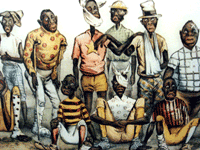 But I’ve come to believe that perhaps my normal grousing is unfair–the Hall doesn’t spend time arguing that public financing for baseball stadiums is heinous, or the steroid issue, etc. And that’s not their job. It’s ours, as fans, and we can take kids through this place and have real dialogue with them if we choose about the current injustices that bother us. That’s one of the beauties of this place. I’d much rather take my kid to see the National Baseball Hall of Fame than Disneyland, if only because it might get said child to want to throw a ball around, which is wonderful exercise. It might provoke them to read. And when they see images like Currier & Ives vicious cartoons lampooning black baseball, they might just ask questions. Questions which will make them better people.
But I’ve come to believe that perhaps my normal grousing is unfair–the Hall doesn’t spend time arguing that public financing for baseball stadiums is heinous, or the steroid issue, etc. And that’s not their job. It’s ours, as fans, and we can take kids through this place and have real dialogue with them if we choose about the current injustices that bother us. That’s one of the beauties of this place. I’d much rather take my kid to see the National Baseball Hall of Fame than Disneyland, if only because it might get said child to want to throw a ball around, which is wonderful exercise. It might provoke them to read. And when they see images like Currier & Ives vicious cartoons lampooning black baseball, they might just ask questions. Questions which will make them better people.
The Hall is a charming place, and its employees are gregarious and kind. I met a pair from the A. Bartlett Giamatti Research Center (otherwise known as “The Father of Paul Giamatti Research Center”), Bill Francis and Tim Wiles, both friendly and kind, the latter actually a reader of Mudville and an author himself, the former introduced electronically by a mutual friend. Bill actually took me on a tour, opening file cabinets with scads of information about every player and personality in the sport, to the library and all the books and bound periodicals, that lovely smell of old paper filling the chilly room.
There are a number of surprising touches in the Hall. The plaques themselves are sometimes very bizarre, often the face looking nothing like the people they’re supposed to represent. But it’s stirring to look upon them, these men who took a bat and whacked a ball for quite a few years and now here they are, asking us to please remember them.
Some tried to capture the essence of the man–Veeck’s smile and open shirt, Landis’ stern gaze, and umpire Bill Klem’s visage seeming to reflect that he’s getting ready to toss you out of the game.
Others are wacky, to say the least: Jackie Robinson looks almost childish, like he’s just happy to be here playing this game and not filled with righteous anger, ready to fight for what he believed in. Cool Papa Bell and Ted Williams likenesses are barely recognizable.
The rest of the Hall is equally intriguing, especially the artifacts gathered throughout the years. One thing I noticed is that the accolades were certainly more fascinating long ago. Nowadays, the cups and plaques and honors are dull. Back in the day–before World War II–the men who hit the diamond and performed better than their competitors were given intricately ornate cups, gilded baseball bats, and watches with their names on the face, or medals, actually, like something you’d see pinned to the chest of some survivor of Flanders Field in the first great war. There were old baseballs, a whole room dedicated to Babe Ruth, displays for individual teams, artifacts like old jackets, equipment, contracts, all the detritus of this wonderful game.
As I wandered through, it did feel as though the troubles of the world would fall away, as it did back in the days I spent at Tiger Stadium, when you’d be in a place that existed only for baseball and the biggest problem would be a weak bullpen. With the state of the world today and this increasingly depressing election upon us, I’ll take this break from reality.
Afterwards, I wandered out into Cooperstown proper. The sun had finally returned after a long absence, and I made my way through the various souveniriums that were scattered through the small downtown. Most had the usual garbage and overpriced autographed bats and ephemera. Then I stumbled into Yastrzemski Sports, and their cheap baseball card bin.
I like baseball cards, but I cannot cotton to collecting them, and paying top dollar for a picture of a ballplayer encased in plastic. I want a piece of cardboard, weathered, looking like someone once owned and traded it years ago and kept it in a shoebox (as I did). When I find one of these–and they have to be cheap–I remove the talisman from its plastic, sniff it, handle it, and put it with the others on my little baseball shrine, where it will no doubt fade and get even more bent.
A kind gent named Dave, a retired postman, greeted me at the front entrance with a hearty “Welcome!” We chatted a bit, and he admitted that it wasn’t his store but his nephew’s, who was indeed a distant relative of the great Carl Yastrzemski. Dave loved working there. “Everyone who comes to Cooperstown is here to have a good time, and the same goes for this shop.” To make things even better, I found baseball cards of my favorite Tigers in the discount pile–Fidrych, Trammell, Whitaker, Bill Freehan, Norm Cash–and all the while Dave played music he’d found online.
So there I was, plumbing the depths of literally thousands of old baseball cards, in search of a Gates Brown (which eluded me), all the while listening to Ricky Nelson, Django Reinhardt, CCR, and other great music. When I found a beat up old Bowman “color television” style card of Carl Furillo, where each player’s photo is framed by a wooden color TV console, I knew I’d lucked out.
Last night, I sat in my little motel room, poring over my cards and reading Jimmy Breslin’s great Can’t Anybody Here Play This Game?, and ate an amazing pepperoni pizza from Sal’s Pizzaria on Main Street (really, it was awesome), I thought to myself that sometimes it works to set aside your bitterness and frustrations and just be pleased with the gifts you’re given. Baseball, for all its vicissitudes, is one of those gifts.
